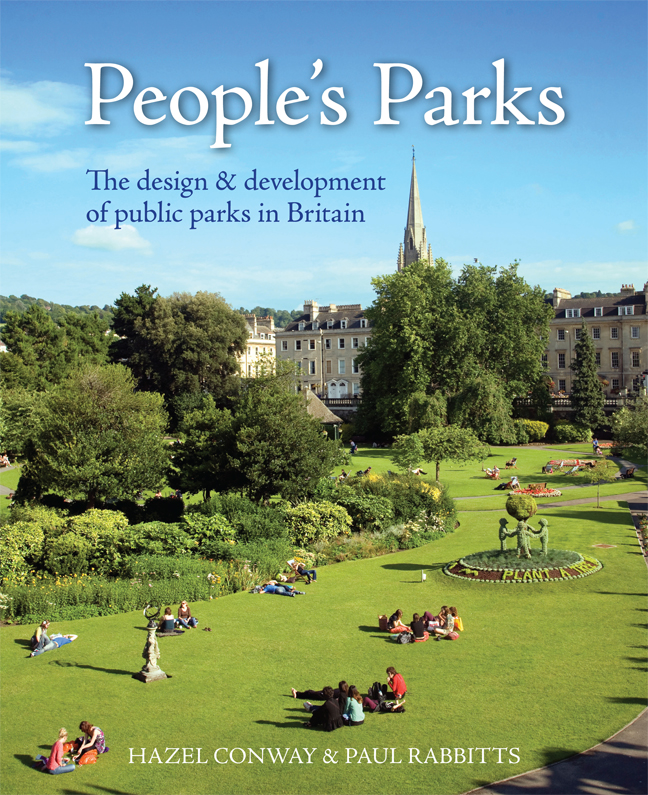Book contents
- Frontmatter
- Dedication
- Contents
- Miscellaneous Frontmatter
- Preface
- Acknowledgements
- Foreword
- A Word from Parks Professionals, Politicians and Parks Organisations
- Introduction: Dr Hazel Conway (1991)
- 1 Public Parks and Municipal Parks
- 2 The Need for Parks
- 3 Pioneering Parks Development
- 4 The Park Movement
- 5 Design and Designers
- 6 Lodges, Bandstands and the Cultivation of Virtue
- 7 Local Pride and Patriotism
- 8 Planting and Park Maintenance
- 9 Permitted Pastimes
- 10 Recreation Grounds, Parks and the Urban Environment
- 11 Public Parks, 1885–1914
- 12 Later Municipal Park Designers
- 13 Garden Cities and the New Towns Movement
- 14 Sport, Physical Activity and Recreation in Public Parks in the Inter-war Years
- 15 Parks Management – a Changing Perspective
- 16 Decline, Revival and Renewal – the Role of Parks into 21st-century Britain
- Appendix 1 Summary of main legislation promoting early park development
- Appendix 2 Chronology of main municipal and public park developments between 1800 and 1885
- Notes
- Bibliography
- Subscription List
- Index
1 - Public Parks and Municipal Parks
Published online by Cambridge University Press: 22 February 2024
- Frontmatter
- Dedication
- Contents
- Miscellaneous Frontmatter
- Preface
- Acknowledgements
- Foreword
- A Word from Parks Professionals, Politicians and Parks Organisations
- Introduction: Dr Hazel Conway (1991)
- 1 Public Parks and Municipal Parks
- 2 The Need for Parks
- 3 Pioneering Parks Development
- 4 The Park Movement
- 5 Design and Designers
- 6 Lodges, Bandstands and the Cultivation of Virtue
- 7 Local Pride and Patriotism
- 8 Planting and Park Maintenance
- 9 Permitted Pastimes
- 10 Recreation Grounds, Parks and the Urban Environment
- 11 Public Parks, 1885–1914
- 12 Later Municipal Park Designers
- 13 Garden Cities and the New Towns Movement
- 14 Sport, Physical Activity and Recreation in Public Parks in the Inter-war Years
- 15 Parks Management – a Changing Perspective
- 16 Decline, Revival and Renewal – the Role of Parks into 21st-century Britain
- Appendix 1 Summary of main legislation promoting early park development
- Appendix 2 Chronology of main municipal and public park developments between 1800 and 1885
- Notes
- Bibliography
- Subscription List
- Index
Summary
The Park rose in terraces from the railway station to a street of small villas almost on the ridge of the hill. From its gilded gates to its smallest geranium-slips it was brand-new, and most of it was red. The keeper's house, the bandstand, the kiosks, the balustrades, the shelters – all of these assailed the eye with a uniform redness of brick and tile which nullified the pallid greens of the turf and the frail trees. The immense crowd in order to circulate, moved along in tight processions, inspecting one after another the various features of which they had read full descriptions in the Staffordshire Signal – waterfall, grotto, lake, swans, boat, seats, faience, statues – and scanning with interest the names of the donors so clearly inscribed on such objects of art and craft as from diverse motives had been presented to the town by its citizens … The town was proud of its achievement, and it had the right to be; for, though this narrow pleasance was in itself unlovely, it symbolised the first renaissance of the longing for beauty in a district long given up to unredeemed ugliness.
Arnold Bennett
Anna of the Five Towns, 1902
The creation of the municipal park has been seen as a prime example of the Victorian ‘aptitude for passionate reform’ and as an attempt to improve the physical, moral and spiritual condition of the urban dweller. Protected from the realities of its city surroundings by gates and railings, it represented an ideal landscape in which the air was clean, the spirit was refreshed by contact with nature, and the body was renewed by exercise. Yet such a view is necessarily an incomplete one, for it does not identify the nature of the improvements, nor how they were viewed by the improvers and the beneficiaries, nor does it tell us how they would be achieved. While the municipal park represented a landscape, it was at the same time a real landscape set in an urban environment and used by local people in various ways.
Municipal parks are public parks, but these were not always as accessible to the public as their name would imply. In order to identify municipal parks to which there was free access, it is important to distinguish between the various forms of public park, but in practice it is not always easy to do so. Landscape gardeners used particular terms precisely, but the park promoters did not.
- Type
- Chapter
- Information
- People's ParksThe design & development of public parks in Britain, pp. 1 - 6Publisher: Boydell & BrewerPrint publication year: 2023



